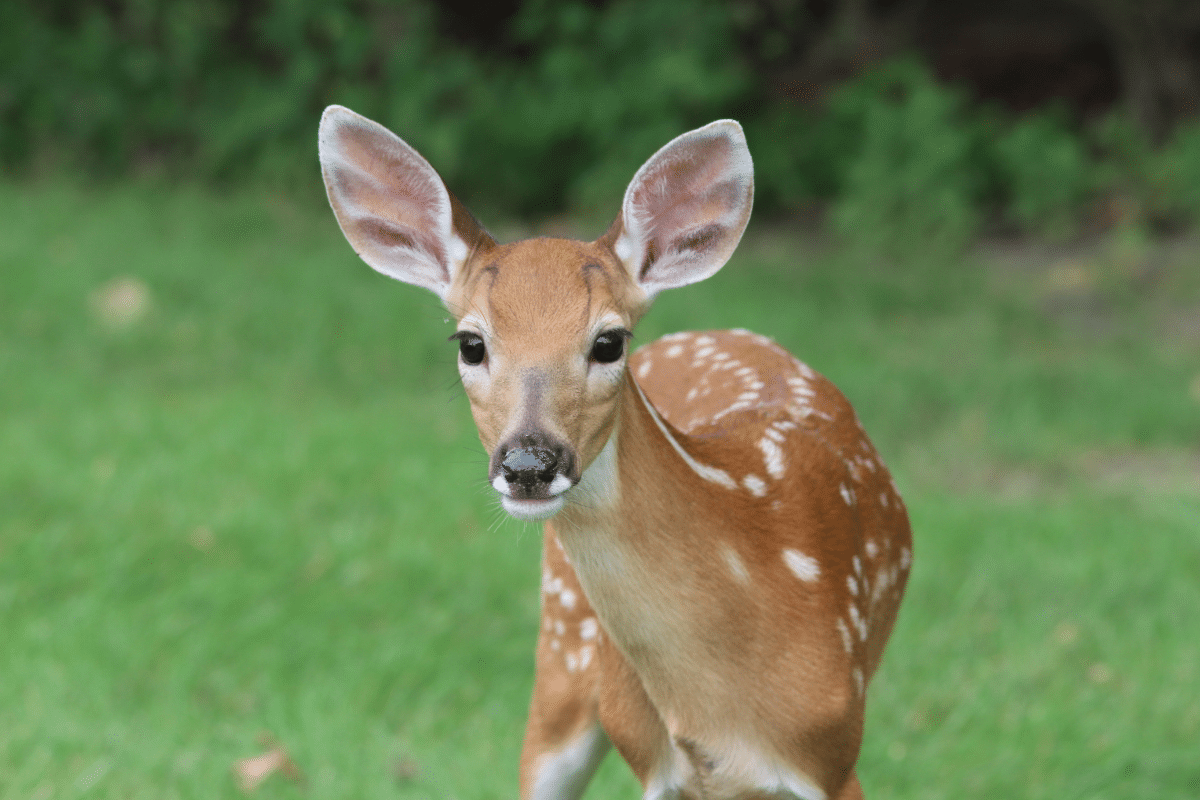Ask Mr. Burger – The deer in my neighborhood seem to be eating everything in sight. What can I plant that the deer won’t eat and how can I keep them out of my garden?
Its easy to get discouraged when you spend good hard earned money and spend precious time to beautify your home and garden with plants and flowers to wake up the next morning and find that the deer have decided that the prior night was a good time to graze at the “salad bar” you just planted for them. So frustrating! There really is no simple guaranteed answer unless your dog stands guard outdoor each night, you live on an island surrounded by piranha or have your yard “locked down” like Fort Knox; but there are some preventative measures that one can take to help reduce the possibility of deer from eating your plants.
First of all, there are some commercial granular products and foliar sprays available like “Deer Scram”, “Liquid Fence” and “Deer Off” that can be placed on and around your plants to help deter deer from eating those protected plants. But these products must be continually reapplied per the manufacturer’s directions and especially after any period of rain to maintain their effectiveness. There is also a technical/mechanical product, “Scarecrow”, that is a motion activated water sprayer that can be used to keep deer away. Just don’t forget to turn the water on!
Another option is to plant plants and flowers that deer don’t tend to like. Following is a list of deer resistant plants and comments taken from “The Old Farmer’s Almanac” website.
First, what is deer candy? Deer love narrow-leaf evergreens, especially arborvitae and fir, and show a preference for hostas, daylilies, and English ivy, according to researchers in the Department of Plant Sciences at the University of Rhode Island in Kingston, who have studied white tailed deer damage to nurseries in the Northeast and report heaviest browsing from October through February. And several growers who participated in the study noted that deer seem to prefer plants that have been fertilized.
Which plants do deer dislike? Not surprisingly, deer stay away from poisonous plants! Daffodils, foxgloves, and poppies are common flowers that have a toxicity that deer avoid. Deer also turn their noses up at fragrant plants with strong scents. Herbs such as sages, ornamental salvias, lavenders, peonies, and bearded irises are just “stinky” to deer. Would you want to eat something prickly? Neither do deer (unless they’re desperate). Plants such as lamb’s ear are not on their preferred menu. Our favorite deer-resistant perennials are bleeding hearts (Dicentra spectabilis). They are popular with us, but not deer!
Keeping in mind that the first rule in deer proofing is that there really are no deer-proof plants! Here is a chart however with some plants that deer rarely or seldom severely damage:
Top Deer-Resistant Plants
Botanical name Common name
Achillea filipendulina Yarrow
Aconitum sp. Monkshood
Ageratum houstonianum Ageratum
Allium sp. Onion
Amelanchier laevis Allegheny Serviceberry
Antirrhinum majus Snapdragon
Armoracia rusticana Horseradish
Artemisia dracunculus Tarragon
Artemisia sp. Silver Mound
Arisaema triphylum Jack-in-the-pulpit
Asarum canadense Wild Ginger
Asparagus officinalis Asparagus
Aster sp. Aster
Astilbe sp. Astilbe
Berberis sp. Barberry
Borage officinalis Borage
Buddleia sp. Butterfly Bush
Buxus sempervirens Common Boxwood
Helleborus sp. Lenten or Christmas Rose
Cactaceae sp. Cactus
Calendula sp. Pot Marigold
Caryopteris clandonensis Blue Mist Shrub
Centaurea cineraria Dusty Miller
Centaurea cyanus Bacherlor’s Buttons
Cleome sp. Spider Flower
Colchicum sp. Autumn Crocus
Consolida ambigua Larkspur
Convallaris majalis Lily of the Valley
Coreopsis verticillata Threadleaf Coreopsis
Corydalis sp. Corydalis
Cytisus sp. Broom
Daphne sp. Daphne
Dicentra spectabilis Bleeding Heart
Digitalis purpurea Common Foxglove
Dryopteris marginalis Wood Fern
Echinacea purpurea Purple Coneflower
Echinops ritro Small Globe Thistle
Endymion sp. Bluebell
Eranthus hyemalis Winer Aconite
Euphorbia marginata Snow-on-the-Mountain
Euphorbia sp. Spurge
Festuca glauca Blue Fescue
Fritilaria imperialis Crown Imperial, Fritilia
Galanthus nivalis Snowdrops
Gypsophila sp. Baby’s Breath
Helichrysum Strawflower
Heliorope arborescens Heliotrope
Hyssopus officinalis Hyssop
Ilex opaca American Holly
Ilex verticillata Winterberry Holly
Iris sp. Iris
Juniperus Juniper
Lantana sp. Lantana
Lavandula sp. Lavender
Limonium latifolium Statice
Lobularia maritima Sweet Alyssum
Marrubium vulgare Horehound
Melissa officinalis Lemon Balm
Mentha sp. Mint
Monarda didyma Beebalm
Myosotis sp. Forget-Me-Not
Myrica pensylvanica Bayberry
Narcissus sp. Daffodil
Nepeta sp. Catmint
Ocimum basilicum Basil
Osmunda Fern
Pachysandra terminalis Pachysandra
Paeonia sp. Peony
Papaver Poppy
Perovskio atriplicifolia Russian Sage
Picea glauca ‘Conica’ Dwarf Alberta Spruce
Pimpinalla anisum Anise
Pinus Pine
Potentilla Cinquefoil
Ranunculus sp. Buttercup
Rhus aromatica Fragrant Sumac
Rosmarinus officinalis Rosemary
Rudbeckia sp. Black-Eyed Susan
Ruta sp. Rue
Salix Willows
Salvia officinalis Garden Sage
Stachys byzantina Lamb’s Ear
Syringa vulgaris Common Lilac
Tanacetum vulgare Common Tansy
Teucrium chamaedrys Germander
Thumus sp. Thyme
Yucca Yucca
Viburnum dentatum Arrowwood Viburnum
Zinnia Zinnia
List courtesy of “Outwitting Deer” by Bill Adler Jr.


